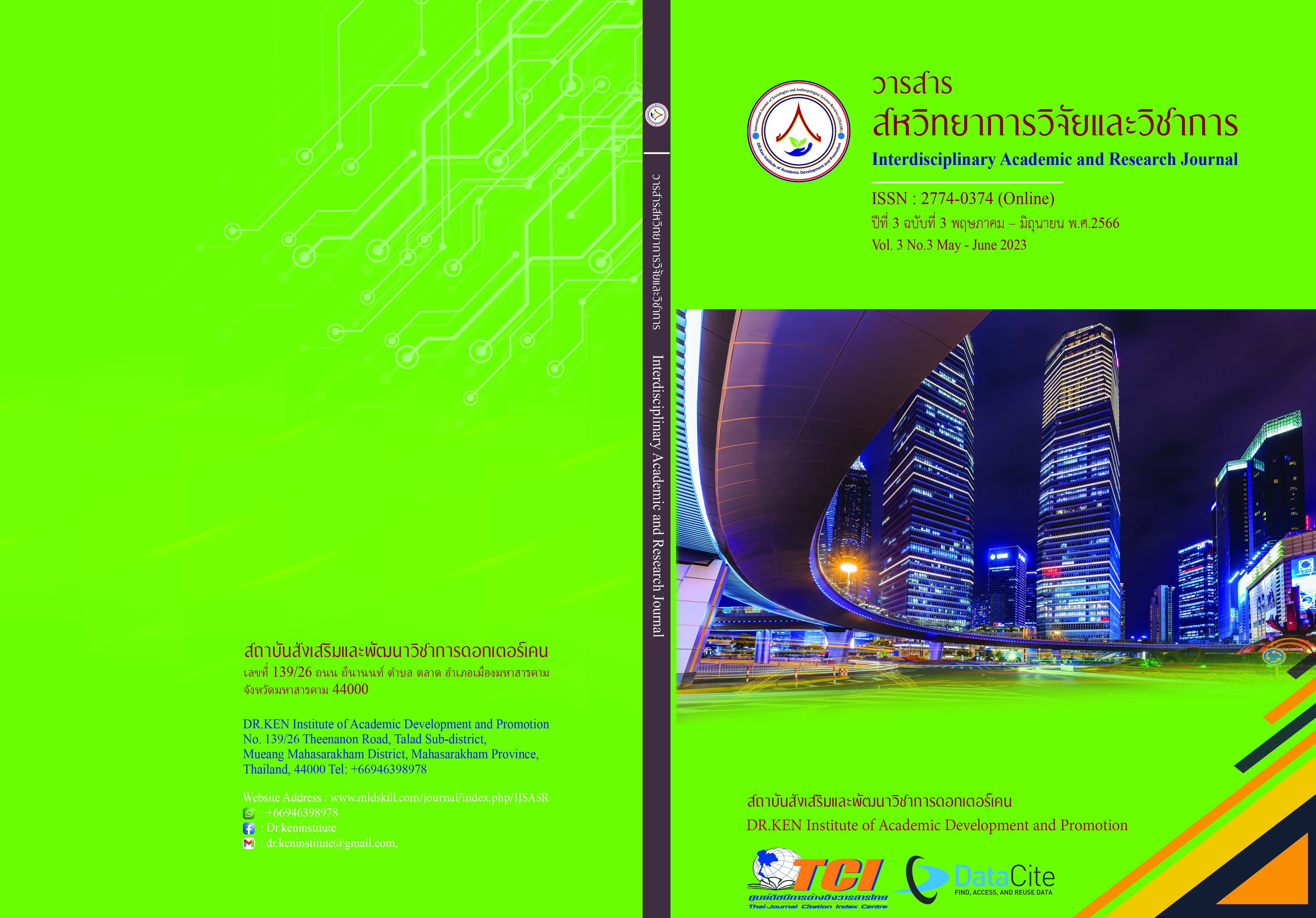The Development of English Vocabulary Pronunciation and Spelling Learning of Grade 5 Students by Using Phonic Teaching Method
DOI:
https://doi.org/10.14456/iarj.2023.146Keywords:
Learning Development; , Vocabulary Pronunciation and Spelling; , Phonic Teaching MethodAbstract
The development of English Vocabulary Pronunciation and Spelling Learning by Using the Phonic Teaching Method is the method of teaching and learning activity to solve the problem of reading aloud and spelling English vocabulary which the researcher used in the classroom mainly to help the students to understand the principle of phonics by comparing each phoneme and then combining them to form a syllable or words which will promote students to read aloud and spell words correctly. It is another way for students to develop their reading skills and be able to apply the experience gained from learning to everyday life. The purposes of this study were to (1) develop English Vocabulary Pronunciation and Spelling Learning of grade 5 students by Using Phonic Teaching Method had met the standard criterion set at 75/75. (2) study the effectiveness index (E.I) of the developed English Vocabulary Pronunciation and Spelling Learning of Grade 5 students by using the Phonic Teaching Method from–test, and Post-test. (3) compare the development of English Vocabulary Pronunciation and Spelling Learning of Grade 5 Students by Using Phonic Teaching Method. (4) study the satisfaction of students with English Vocabularies Pronunciation and Spelling Learning activities by Using Phonic Teaching Method. The subjects of this study were 45 students of grade 5/2 at The Holy Infant Jesus Mahasarakham School who enrolled in the second semester of the academic year 2019. The instruments used in conducting this study were; (1) 16 lesson plans, (2) a 30- item of 4 alternatives multiple choices of English Vocabularies Pronunciation and Spelling test, and (3) a questionnaire of satisfaction on English Vocabulary Pronunciation and Spelling Learning activity by Using Phonic Teaching Method. The statistics used in data analysis were means, standard deviation, percentage, and t-test. The results of this study were: (1) The lesson plans for English Vocabularies Pronunciation and Spelling Learning by using the Phonic Teaching Method developed by the researcher revealed efficiency at 82.37/79.86 which was higher than the standard criteria set at 75/75. (2) The effectiveness index of the English Vocabularies Pronunciation and Spelling Learning by Using Phonic Teaching Method suggested at 0.514 The finding expressed those students had gained their learning progress at 51.40%. (3) The result of the development of English Vocabulary Pronunciation and Spelling Learning of Grade 5 Students by Using Phonic Teaching Method was statistically significant at .05. And (4) The satisfaction of target students to English Vocabularies Pronunciation and Spelling Learning Activities by Using Phonic Teaching Method revealed at 4.41 suggested in a high level.
References
กระทรวงศึกษาธิการ. (2551). หลักสูตรแกนกลางกลางการศึกษาขั้นพื้นฐาน พุทธศักราช 2551.กรุงเทพฯ: คุรุสภาลาดพร้าว.
ดวงใจ ตั้งสง่า. (2556). ชวนลูกเรียนรู้ภาษาอังกฤษ ตอน โฟนิคส์คืออะไร ทำไมต้องเรียน. Retrieved on 13 July 2019, from: http://taamkru.com/th/โฟนิคส์คืออะไร-ทำไมต้องเรียน
ทศพร ตาดสุวรรณ์ (2550). การพัฒนาแบบฝึกเสริมทักษะการเขียนคำศัพท์ภาษาอังกฤษ ชั้นประถมศึกษาปี ที่ 4. วิทยานิพนธ์ปริญญาการศึกษามหาบัณฑิต (สาขาการพัฒนาหลักสูตรและการเรียนการสอน). คณะครุศาสตร์มหาวิทยาลัยราชภัฏ อุบลราชธานี.
นฤมล สุปินโน. (2558). ผลการใช้วิธีสอนแบบโฟนิกส์ เพื่อพัฒนาทักษะการอ่านออกเสียงภาษาอังกฤษ และเจตคติ ต่อการอ่านแบบโฟนิกส์ของนักเรียนชั้นประถมศึกษาปีที่ 2 โรงเรียนบ้านนาป่าแปก จังหวัดแม่ฮ่องสอน . มหาวิทยาลัยสุโขทัยธรรมาธิราช/นนทบุรี.
พิมภรณ์ พวงชื่น . (2561). การพัฒนาชุดกิจกรรมการเรียนการสอนแบบโฟนิกส์ เพื่อส่งเสริมทักษะการอ่านและสะกดคำสำหรับนักเรียนชั้นประถมศึกษาปีที่ 1. พิษณุโลก: มหาวิทยาลัยนเรศวร.
มาลินี พุ่มมาลัย. (2558). การพัฒนาหนังสืออิเล็กทรอนิกส์ เรื่อง การสะกดคำศัพท์ภาษาอังกฤษด้วยวิธีโฟนิกส์ (Phonics) สำหรับนักเรียนชั้นประถมศึกษาปีที่ 3. พิษณุโลก: มหาวิทยาลัยนเรศวร.
รุ่งอรุณ โรจน์รัตนา และดำรง ไชยศรี. (2560). วิธีการสอนแบบโฟนิกส์. สารานุกรมศึกษาศาสตร์ (Encyclopedia of Education), 52(1), 48-55.
รุสลาน สาแม และเปรมินทร์คาระวี. (2558). พฤติกรรมการออกเสียงพยางค์หนัก-เบา ในคำภาษาอังกฤษจากผลของการสอนแบบฟัง-พูด ร่วมกับการสอนความรู้ทางสัทศาสตร์: การศึกษานักเรียนชั้นมัธยมศึกษาปีที่ 4 โรงเรียนศิริราษฎร์สามัคคี อำเภอมายอ จังหวัดปัตตานี. วารสารศึกษาศาสตร์ มหาวิทยาลัยสงขลานครินทร์ วิทยาเขตปัตตานี, 26 (1), 85-99.
วนิดา โนนคำ. (2554). ผลการใช้วิธีการสอนแบบโฟนิกส์ที่มีต่อความสามารถในการอ่านและความคงทนในการเรียนรู้ของนักเรียนชั้นมัธยมศึกษาปีที่ 1 ที่มีปัญหาในการเรียนรู้ โรงเรียนศรีจันทร์วิทยาคม รัชมังคลาภิเษก จังหวัดเพชรบูรณ์ . นนทบุรี: มหาวิทยาลัยสุโขทัยธรรมาธิราช.
อินทิรา ศรีประสิทธิ์. (2552). ทฤษฎีใหม่ในการสอนภาษาอังกฤษสำหรับคนไทย. การประชุมนานาชาติของ UNESCO-APEID และมหกรรมวันครูโลก ครั้งที่ 12 (English session) Teacher Training for Student Centered Learning (การอบรมครูในสภาพแวดล้อมที่มีนักเรียน เป็นศูนย์กลางการเรียนรู้), 174-178. กรุงเทพฯ: มูลนิธิเพื่อการเรียนรู้ตลอดชีวิต.
Harris, T., & Hodges, R. (Eds.). (1995). The literacy dictionary (p. 207). Newark, DE: International Reading Association.
Krashen, S. (2004). The power of reading: insights from the research. 2nd edition. The USA. Retrieved from: http://ejournals.swu.ac.th/index.php/ENEDU/article/viewFile/10010/8493
Lewis, J. Windsor. (2002). The teaching of English pronunciation: The model accents. Journal of the International Phonetic Association, 17 (2), 139 – 141. DOI: https://doi.org/10.1017/S0025100300003364
Downloads
Published
How to Cite
Issue
Section
License
Copyright (c) 2023 วิดาด์ อัล บัททาห์, ภูษิต บุญทองเถิง, ทัศนีย์ นาคุณทรง

This work is licensed under a Creative Commons Attribution-NonCommercial-NoDerivatives 4.0 International License.
Copyright on any article in the Interdisciplinary Academic and Research Journal is retained by the author(s) under the under the Creative Commons Attribution-NonCommercial-NoDerivatives 4.0 International License. Permission to use text, content, images, etc. of publication. Any user to read, download, copy, distribute, print, search, or link to the full texts of articles, crawl them for indexing, pass them as data to software, or use them for any other lawful purpose. But do not use it for commercial use or with the intent to benefit any business.
















.png)


